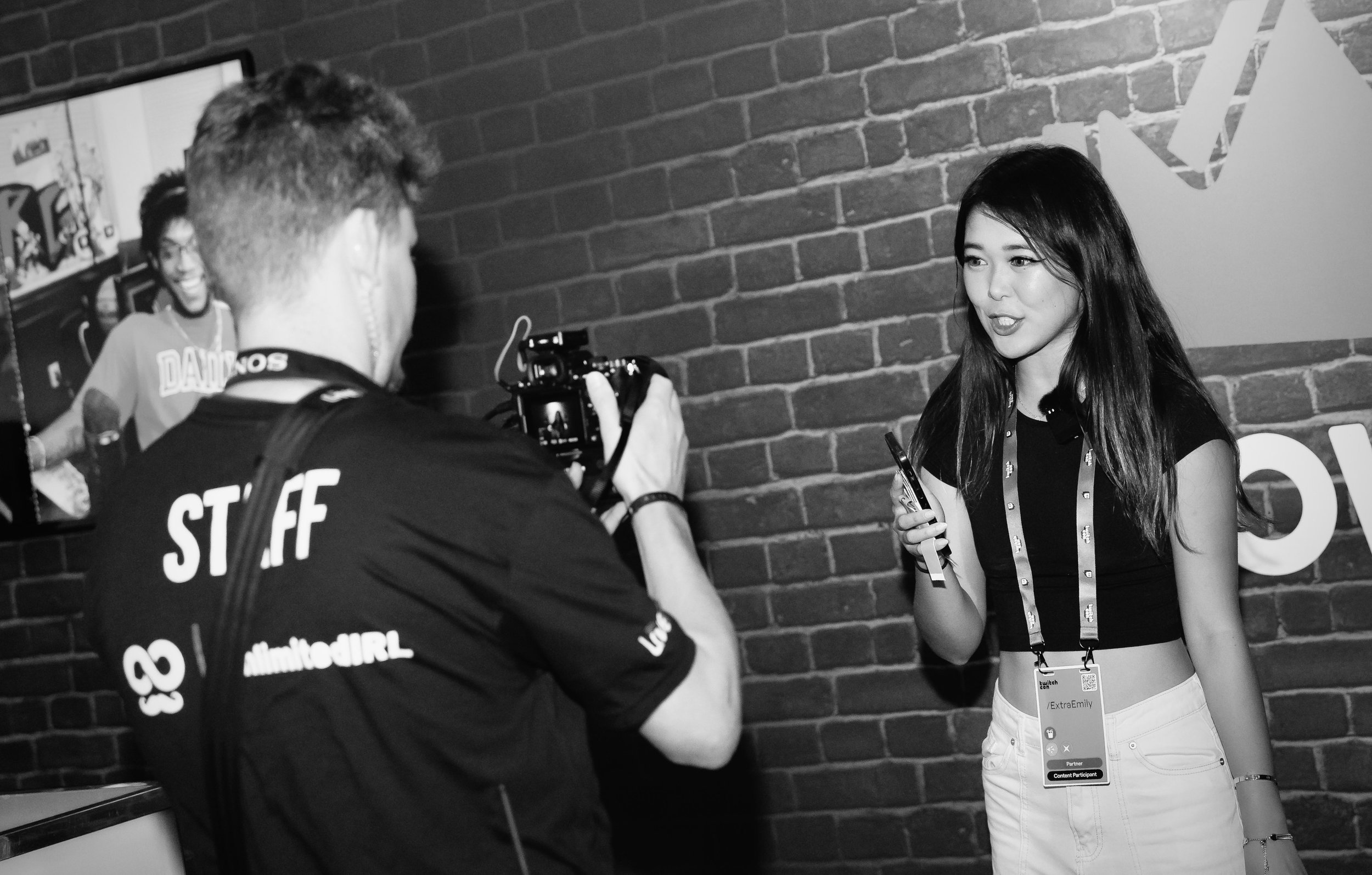Guide to IRL Streaming
Creating deep viewer connections with the shared experiences of live
by Taylor Webb & Joel Wilcox
What is IRL Streaming?
IRL streaming, or "In Real Life" streaming refers to broadcasting live video content from real-world locations and situations. Unlike traditional live-streaming which often involves stationary setups at desks or studios, IRL streaming allows creators to share their experiences and interactions as they happen, anywhere in the world.
IRL streaming has gained popularity with the rise of non-gaming content genres on platforms like Twitch and YouTube where viewers can follow along in real-time as streamers navigate the real world - the ultimate video game. IRL Streamers can adapt their plans on the fly, responding to live comments and occurrences, which can alter the content direction instantaneously. This results in a much different viewing experience than, for example, a YouTube vlog - where the comments aren’t received by the creator until after the video is shot, edited and uploaded. Many IRL streamers find that the interactivity of live leads to a more genuine connection with viewers - who feel directly involved in the content creation process. This can create deep viewer / creator connections.
IRL streaming can be:
Outdoor Adventures & Travel: Some streamers take viewers on hikes, urban explorations and visit tourist attractions in different cities or countries, offering a firsthand look at different cultures, cuisines, and landmarks - while providing live commentary and engaging with viewers through their platform’s chatroom.
Jinnytty, a full-time travel IRL Twitch streamer from Korea - streamed her trek across Taiwan. Her over one-thousand kilometer adventure, dubbed “Waddlethon”, brought her to the top of the viewer charts on Twitch, peaking at over 27,000 viewers on her channel. Jinny’s adventure was interactive, and she became a tourist attraction during her journey - at one point a bus of tourists drove past her with dozens of occupants waving thru the window. This wasn’t without it’s moments - Jinny & her viewers encountered a veiled stalker that followed her around for hours [The police were contacted and the stalker was institutionalized.]
Creative Processes: Artists, musicians, and performers use IRL streaming to showcase their creative process or performances in real time. IRL streamer JoeyKaotyk is known for his sometimes impromptu breakdancing streams, expressing his talent all over the world.
Daily Life & Social Interactions: Some IRL streams are creators simply sharing their everyday routines - whether it's cooking meals, running errands, or spending time with friends and family. Some may attend events, parties, or gatherings, interacting with people they encounter and showcasing spontaneous moments. Sometimes resulting in an interactive reality show. Twitch CEO Dan Clancy has IRL streamed with many of his platform’s streamers - this level of engagement from a CEO helps demystify Twitch's operations and builds trust through transparency, making both the viewer & stream experience more informed and connected. The raw, live format of IRL streaming creates moments for authentic dialog with creators and the Twitch audience.
IRL streaming is one of the most engaging forms of content for viewers because it provides a sense of immediacy and authenticity, allowing viewers to feel more connected to the streamer's experiences. As viewer connections deepen, creators can feel a freedom to express themselves without fear of “losing” their audience.
However, IRL streaming also comes with some unique technical challenges, especially in densely-populated locations and areas with poor cellular signal. But before we delve into today’s IRL streaming challenges, let’s look at where it started.
IRL Streamer CookSux streaming from the top of the Eiffel Tower in Paris, France
IRL Streamer Jinnytty streaming from Albuquerque, New Mexico during the International Balloon Fiesta
Breakdancer & IRL Streamer JoeyKaotyk streaming from Porto, Portugal
Image from Techcrunch showing early Justin Kan’s early IRL streaming setup
The First IRL streamer?
Before we called them IRL Streamers - live streaming on the internet has a storied history that dates back to the early 1990s, long before the advent of modern platforms like YouTube, Twitch, or Facebook. One of the earliest milestones occurred on June 24, 1993, when the band Severe Tire Damage, comprised of computer scientists from high-profile tech companies, performed the first live concert over the Internet using the then-novel MBONE technology. This pioneering live stream wasn’t exactly accessible, apparently using over half the available bandwidth of the internet at the time.
Fast forwarding thru 14 years of the fastest technological advancement in the history of man - it’s 2007 - the internet is a bit more mature. Justin Kan and Emmett Shear decide to launch the site Justin.tv as a live reality show broadcasting Justin’s life 24/7 (similar in spirit to todays IRL streamers)
The technology used by Justin Kan to stream his daily life? A wearable computer system, a webcam attached to a baseball cap, and a backpack equipped with a computer and batteries. His custom setup’s video encoder, the Axis 241S, allowing him to stream live with Sprint’s (at the time) new EVDO 3G network - at a max bitrate of about 1200Kbps. This setup, while innovative, was cumbersome and not practical for average users who might be interested in live streaming their lives - today’s IRL streamers.
Of course - in 2007 the technology required for constant “IRL” live streaming was neither widely available nor user-friendly. From the perspective of someone in 2024, it’s fair to say that Justin.tv was ahead of it’s time.
As time went on, Justin.tv allowed users to create their own live channels and laid the groundwork for what would become sister website Twitch.
Initially focused on live gaming content, Twitch introduced features like live chat, which enabled direct interaction between streamers and their audience. Chat interactivity and deep viewer connections thru the shared experience of live has since propelled Twitch to it’s position as the number one live streaming website.
Twitch initially focused almost exclusively on video “gaming” content, and did not officially allow non-gaming content until late 2015, when it expanded its content categories to include creative content like music, art, and other non-gaming activities.
Periscope launched in 2015 and allowed people to live stream directly from their smartphones, gaining significant traction as a medium for creative live video.
The first approved mobile live streaming we saw from Twitch was in July of 2016, when it began allowing Pokémon Go streams, coinciding with the mobile game's surge in popularity. In that same month Twitch officially introduced the "Social Eating" category, after observing the popularity of the format among South Korean streamers. This allowed streamers to interact with their communities while having a meal, whether during a break from gaming or as part of a dedicated food-themed broadcast.
Finally, on December 15, 2016, Twitch introduced its IRL (In Real Life) streaming category, returning in some way to the original vision of Justin.tv. Twitch’s success with monetization tools like “subs”, donations & ad-based revenue had made it a mainstay for the creator economy.
Anxious to use these tools to create a new experience for viewers, but also eager to explore content other than gaming, we have witnessed the IRL Streamer reborn - using the Twitch platform [and other sites] with its core concepts of live and interactivity.
Getting Started in IRL Streaming
The most recent explosion in popularity of IRL streaming on Twitch, YouTube, and newer websites like Kick, has been aided by advances in mobile streaming technology and ease of access to high quality mobile streaming solutions.
Whether you’re just beginning your content creation journey or you’re looking to expand your existing content creation to include indoor / outdoor IRL streaming, using a cell phone is one of the easier and most common ways to get started. While some platforms offer phone apps for streaming, like the Twitch app, there are a few more sophisticated apps available that allow for streaming to most consumer streaming platforms, with advanced features like onscreen graphics and cellular bonding:
Moblin - Open-source IRL Streaming app for iPhone
IRLPro - Open-source IRL Streaming app for Android
These relatively new apps take advantage of the extremely powerful processors in modern smartphones and make it easy to start IRL streaming without purchasing extra equipment. For a stable, high quality stream, phone apps can be a great start, but aren’t magic. Even Moblin and IRLPro won’t work if there is no cellular service, or the area is so crowded that the service is not adequate.
Advanced IRL Streaming: IRL Backpack
Many of today’s full-time streamers use the IRL Backpack for their IRL streams, as a significant upgrade in both quality and stability compared to smartphone-based streaming solutions.
In 2018, UnlimitedIRL in collaboration with Gunrun - then a Twitch staff member, began offering the IRL Backpack as an all-in-one mobile streaming solution. Built around the LiveU Solo video encoder, the IRL Backpack allows for high quality IRL streaming from any camera with an HDMI port, from nearly anywhere in the world.
Similar to modern TV news broadcasts, the IRL Backpack uses cellular bonding technology to combine signals from multiple 4G/5G cellular networks, ensuring reliable and high-quality broadcasts for IRL streamers who require robust broadcast capabilities in various environments. This technology is particularly valuable for streamers who travel frequently or find themselves in crowded and remote locations. With the unlimited data add on, streamers can use their IRL Backpack in over 110 countries with minimal additional complexity, eliminating the need for creators to worry about finding compatible SIM cards or modems for their IRL Backpack.
Trusted & used by some of the world’s biggest streamers including jakenbakeLIVE, xQc, Jinnytty, Tfue, and HasanAbi - and brands such as Razer, Wendy’s, StockX, Riot, Twitch, Warner Media and Comcast Spectacor.
Interested in trying out the IRL Backpack? Look for the UnlimitedIRL booth at TwitchCon San Diego this year. Fill out the contact form of the bottom of the page and we’ll be sure to email you an invite link to a live demo at the show later this year.










